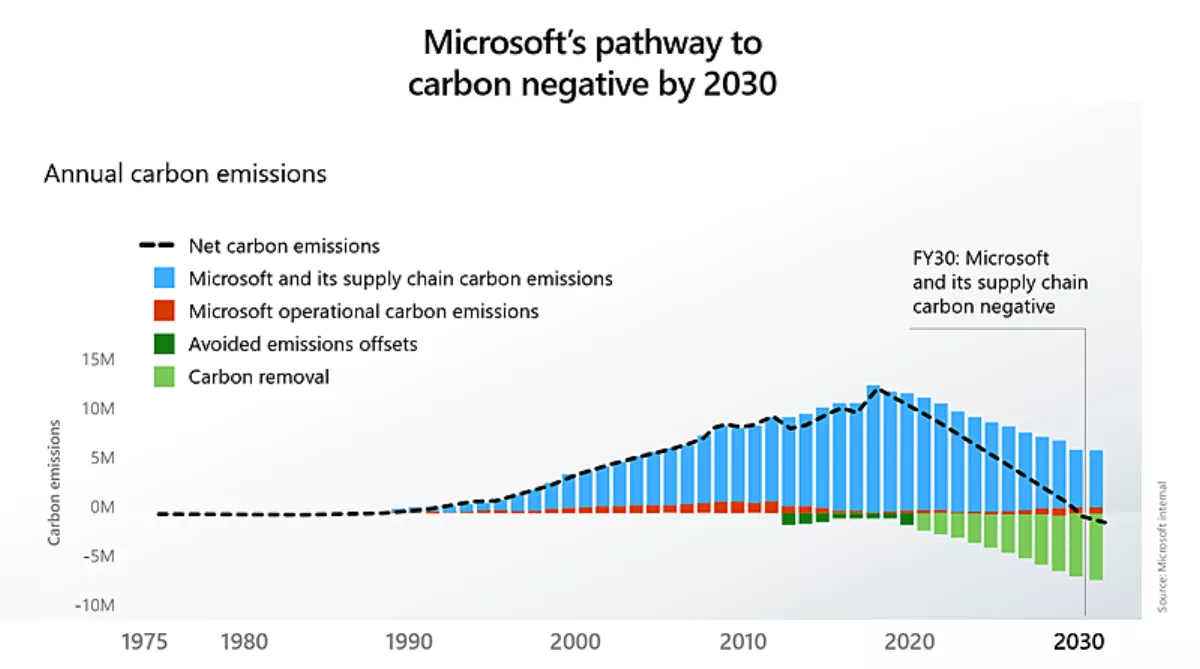Microsoft’s ‘moonshot’ goals to be carbon negative by 2030
Microsoft's president Brad Smith has made a bold 'moonshot' announcement that the company will become completely carbon negative by 2030.
Not only is Microsoft striving to eliminate its future carbon footprint, but the company also aims to remove all carbon it has directly or indirectly emitted into the environment by 2050.
In a company blog post, Smith declares that the world is facing an urgent carbon problem that will result in catastrophe for the earth if people don't work together to curb emissions.
He explains that climate experts agree there must be urgent action to bring down emissions, essentially reaching 'net zero'. Net zero is the term for removing as much carbon as it creates every year.
He says this is why Microsoft has made an ambitious goal to reduce and remove its carbon footprint.
"By 2030 Microsoft will be carbon negative, and by 2050 Microsoft will remove from the environment all the carbon the company has emitted either directly or by electrical consumption since it was founded in 1975," he states.
But bold goals require bold and detailed plans. Smith explains that Microsoft will fund its goals in part by expanding its internal carbon fee to start charging for emissions across supply and value chains, as well as direct emissions from Microsoft.
Microsoft is ensuring that its supply and value partners adjust to the changes through the launch of a new initiative to help them use Microsoft technologies in order to reduce their own carbon footprints.
Microsoft is also creating a US$1 billion climate innovation fund to work on carbon reduction, capture, and removal technologies. Furthermore in 2021, Microsoft will incorporate carbon reduction a core part of its procurement processes for its supply chain.
Smith outlines seven principles that guide Microsoft efforts in tackling societal issues. Grounding in science and math; Taking responsibility for our carbon footprint; investing for new carbon reduction and removal technology; empowering customers around the world; ensuring effective transparency; using Microsoft's voice on carbon-related public policy issues; and enlisting employees.
Microsoft further details how it will reduce emissions, based on the science-based definitions of scopes. Scope 1 emissions are direct emissions, scope 2 emissions are indirect emissions from production of energy, and scope 3 emissions are indirect emissions from other sources.
Smith explains that Microsoft will reduce scope 1 and 2 emissions to 'near zero' by the middle of the decade by:
- Shifting to 100% supply of renewable energy by 2025, meaning that Microsoft will have power purchase agreements for green energy contracted for 100% of carbon emitting electricity consumed by Microsoft data centers, buildings, and campuses.
- Microsoft will electrify its global campus operations vehicle fleet by 2030.
- Microsoft will pursue International Living Future Institute Zero Carbon certification and LEED Platinum certification for its Silicon Valley Campus and Puget Sound Campus Modernisation projects.
Microsoft will reduce scope 3 emissions by more than half by 2030 through new steps, including the following:
In July 2020 Microsoft will start phasing in our current internal carbon tax to cover our scope 3 emissions. Currently this fee is $15/metric ton and covers all scope 1 and 2 emissions, plus scope 3 travel emissions. Unlike some other companies, our internal carbon tax isn't a "shadow fee" that is calculated but not charged.
"Microsoft's fee is paid by each division in our business based on its carbon emissions, and the funds are used to pay for sustainability improvements," says Smith.

By 2030 Microsoft will remove more carbon than it emits, setting us on a path to remove by 2050 all the carbon the company has emitted either directly or by electrical consumption since it was founded in 1975. It will achieve this through a portfolio of negative emission technologies (NET) potentially including afforestation and reforestation, soil carbon sequestration, bioenergy with carbon capture and storage (BECCs), and direct air capture (DAC).
Microsoft will also invest in new carbon reduction and removal technology to support its goal.
"It won't be easy for Microsoft to become carbon negative by 2030," says Smith, "But we believe it's the right goal. And with the right commitment, it's an achievable goal. We will need to continue to learn and adapt, both separately and even more importantly in close collaboration with others around the world.
"We believe we launch this new initiative today with a well-developed plan and a clear line of sight, but we have problems to solve and technologies that need to be invented. It's time to get to work."


